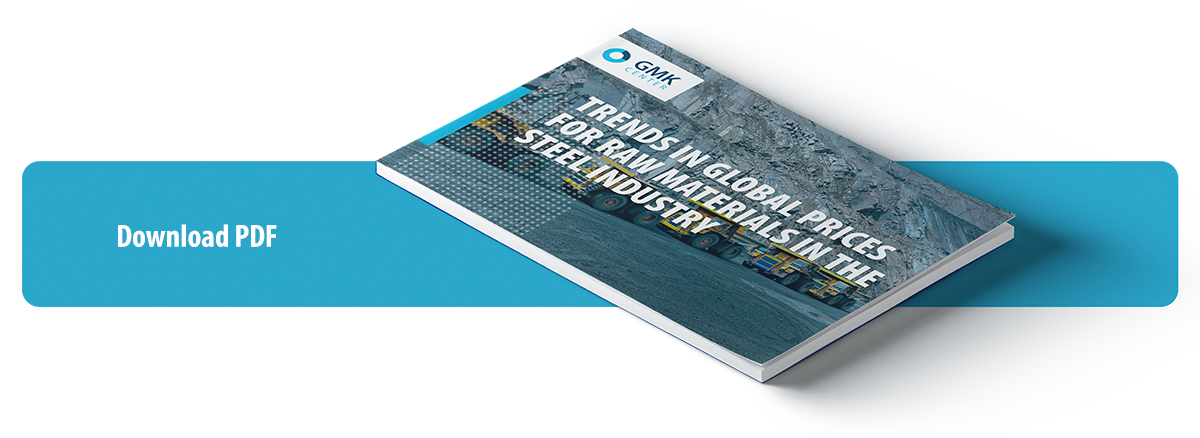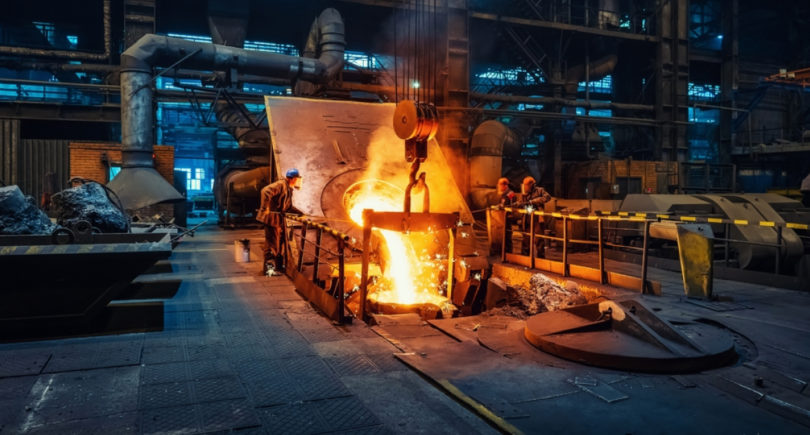
Iron ore quotations will continue to decline in 2020. China plays a decisive role again
In November, iron ore prices fell back to the level of late 2018–early 2019. Before that, different factors influenced fluctuations of quotations of raw materials used in steelmaking for most of this year. As a result of movement of quotations for iron ore and scrap over the year, they were often different.
In the mid-year, experts pointed out that the traditional relationship between raw materials prices started to disappear. According to S&P Global Platts, a correlation between prices for iron ore (CFR China) and large scrap (CFR Turkey) exceeded 87% in 2014–2016. In 2017–2018, this relationship considerably weakened, and started to completely disappear in 2019.
Earlier, a change in scrap price sparked a relevant response from iron ore quotations. This used to be a guiding trend for market participants. This year, however, traders, discouraged by a pronounced change in the usual course of events, attempted to offer different solutions for restoring a stable picture of the world. Some of them started to pay more attention to fluctuations in prices for finished steel. They say that these fluctuations reflect the trends in quotations for Turkish scrap metal and iron ore imported by China.
The autumn however brought some adjustments. The correlation between scrap and iron ore prices started to restore. Will the trend towards strengthening the relationship continue in 2020?
Global factors
Average annual iron ore prices are still around a third higher than the 2018 quotations. From late January to August, iron ore went up due to a sharp supply deficit in the global market. Shipments from Brazil declined as a result of suspension of several companies due to the collapse of Vale’s tailings dam. The situation was aggravated by force majeure, declared by Australian companies because of Cyclone Veronica.
“Actual reduction in ore production proved to be much higher than declared early this year. Meanwhile, high demand was recorded in China due to economic stimulus programs. Amid the growing trade dispute with the U.S., Beijing invested heavily in infrastructure,” explains Andrii Tarasenko, GMK Center Chief Analyst.
As a result, iron ore reserves in Chinese ports reached their minimum over 2.5 years in July, 115 million tons. Yet, iron ore supply somewhat improved starting July. Reserves in ports started to increase. This immediately affected the prices. The ceiling quotation for iron ore fines 62% Fe (China, CFR from Australia) exceeded $120 per ton.
In August, iron ore quotations declined by 32% compared to their maximum in July. In mid-November 2019, they were close to the levels recorded at the beginning of this year, $82 per ton of iron ore fines 62% Fe.
Scrap prices did not depend on movement in iron ore quotations for most of the year. The market situation in this segment was influenced by other factors than those in the iron ore market.
Demand for scrap in China increased by 20% in January–June 2019. However, this did not affect the prices outside of China. Back in December 2018, China imposed restrictions on scrap imports. In August, Chinese steelmakers imported no scrap for the first time since 2000.
“Turkey sets the scrap price as the main importer with a 20% share in world imports. The crisis in the Turkish steel industry prompted an 11% decline in scrap imports over 9 months of this year. As the supply of the U.S. scrap is inelastic, Turkish producers managed to push down the prices. As a result, scrap prices fell by 20% by early October, down to a minimum of $225 per ton,” says Andrii Tarasenko.
Prices for coking coal in November decreased by 39% to $134 per ton compared to the same period of the previous year.
“China continued its policy of restricting coking coal imports from Australia. Outside of China, steel production dropped by 0.77% over 9 months. Therefore, the increase in coal supply put pressure on the prices,” explains Andrii Tarasenko.
Besides, in the spring of this year, Russia restricted exports of coking coals to Ukraine. This also increased the supply in Asian markets.
Another reason for the fall in coal prices is presumably a rise in iron ore prices. Steelmakers put pressure on coal suppliers, because they turned out to be on the verge of profitability, as they could not make buyers pay the iron ore price margin due to a weak demand.
Local specifics
This year, Ukrainian steelmakers attempted to take advantage of the favorable price situation in the iron ore market. According to the customs statistics, iron ore exports in January–October increased by 8.3% compared to the same period of the previous year, up to 33.26 million tons or by $2.977 billion. For comparison, during the entire last year, Ukraine’s mining & metals sector shipped 36.9 tons of iron ore to foreign markets worth $2.869 billion.
Yet, in autumn, the volume of iron ore shipments to foreign markets started declining. In September, Ukraine’s exports of iron ore and iron ore concentrates grew by 1.8% to 3.2 million tons compared to August. In October, Ukraine’s mining & metals sector exported 2.86 million tons of iron ore. This is 10% down from September.
In 2019, scrap exports from Ukraine was virtually suspended because of the imposition of a safeguard export duty. In January–October, scrap collecting companies shipped a total of just 40.7 thousand tons to foreign markets worth $11.3 million against 327.5 tons worth $105.6 million supplied last year.
Domestic scrap prices seem to be close to bottom. A potential decrease in prices in Ukraine is limited due to the deficit of easily accessible scrap.
“In September, steel companies carried out a phased reduction of prices to ₴5,200–5,300 per ton. This seems to be the lower boundary. In the global market, prices also fell to $240 per ton (e.g. September decline in Turkey). I don’t however think that the market will go down below $220 per ton until the end of the year,” Kostyantyn Bass,, Chairman of the Supervisory Board at Ukr-Met Alliance LLC, predicted earlier.
Ukraine still has a negative balance of foreign trade in coke and coking coal. This situation arose back in 2014 when Ukraine lost some of its blast-furnace fuel production capacities in the non-government controlled areas.
At the same time, the deficit was eliminated this year partly due to a decrease in the output and partly due to companies’ initiatives to optimize supplies of raw materials. As a result, in September and early October, the demand for coke among steelmaking companies decreased.
“Both small coke plants and large ones, like Avdiyivka Coke Plant, cut coke production. The available coking coal, both imported and domestic, is sufficient to fully meet the needs of the plants,” says Anatoliy Starovoit, CEO at Ukrkoks Association.
According to the customs statistics, Ukraine imported 847.8 thousand tons of coke and coals worth $256.2 million in the first 10 months of 2019, and 839.8 thousand tons worth $251.7 million in 2018.
Prospects and expectations
Almost all consulting companies and market operators themselves anticipate a drop in iron ore raw prices. SteelHome believes that in 2020, the iron ore price will fall by 10–15% down to $65–95/ton (CIF, China). World Steel Dynamics says the price for iron ore fines in China will drop from $87 in October 2019 to $65 in December 2019–January 2020, with a further increase to $70–75. Citigroup expects $75 by the end of 2020, with a further decline to $55 over the next 5 years. Australia’s Ministry of Industry, Innovation and Science forecasts $57, FOB Australia, until 2021.
According to GMK Center’s consensus forecast based on the data provided by 10 consulting and investment companies, iron ore fines will be priced at $66–76 per ton in 2020–2023.
Several factors will contribute to a downward trend. According to SteelHome, China’s steel production will decrease by 2% in 2020. Hence, the need for iron ore will also decrease by 2%. Demand outside of China will be weak.
Besides, 2020 is expected to bring improvement in iron ore supply. Vale plans to put suspended capacities of 60 million tons into operation. According to Australia’s Department of Industry, Innovation and Science, the country will increase iron ore exports by 60 million tons in 2020–2021 due to investments of leading companies in capacity expansion.
Australia’s Department of Industry, Innovation and Science expects a 15% decrease in average prices for hard coking coal in 2020, down to $158 (FOB Australia).
Expectations on scrap prices are conservative. As for the situation in Turkey’s economy, there are no prospects for rapid improvement. The movement of prices since mid-October from the minimum to $260–265 is temporary, according to Irepas, and due to a replenishment of stocks rather than a growth in demand. The imbalance in iron ore and scrap prices will gradually lessen due to a fall in iron ore prices.
Much will depend on China’s policy of scrap import restrictions. A rise in scrap prices in China caused a loss of profit by local electric-arc steelmakers. Meanwhile, the government encourages reduction of CO2 emissions, by expanding the use of scrap in production, among other things. Hence, policy changes are likely. This will adjust prices both in China and in the global market. In November, the difference in prices amounted to around $100 per ton.
Download the full version of GMK Center’s report on trends in global prices for raw materials in the steel industry here.






